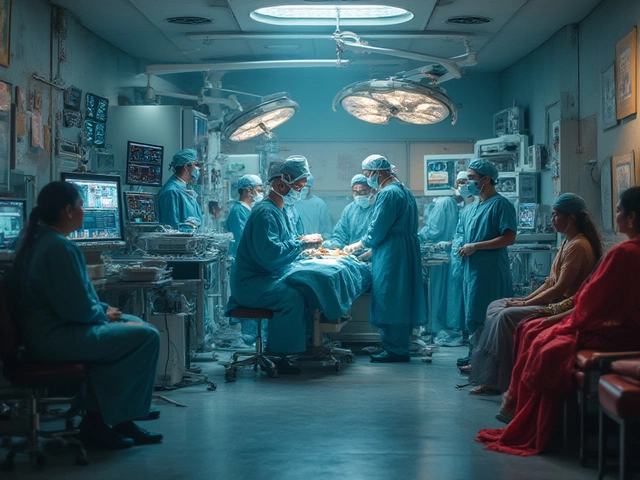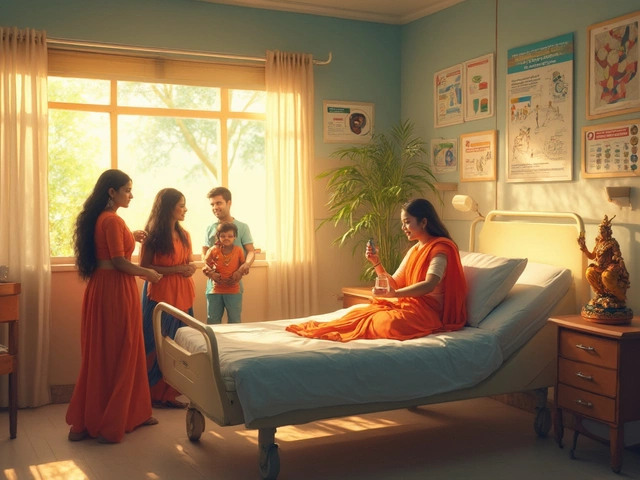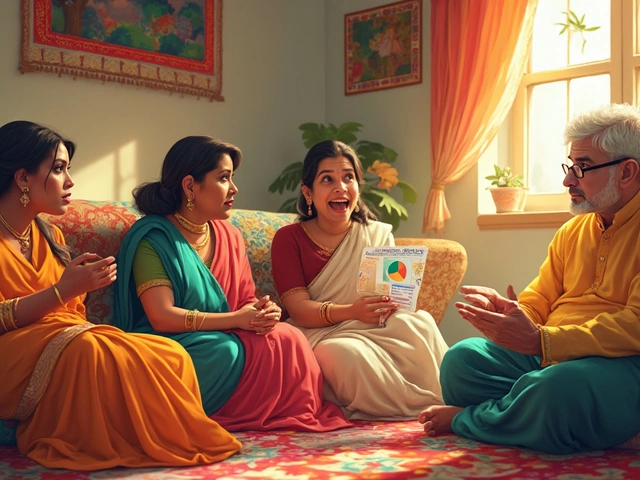Here’s a fact that stops most people in their tracks: not all cancers are created equal. Some just refuse to play fair, ignoring treatments and coming back again and again. If you’ve ever wondered which one is the true heavyweight when it comes to being hard to cure, you’re not alone. It’s a question that keeps doctors and researchers up at night—because curing cancer isn’t a one-size-fits-all deal.
Instead, some cancers hide deep in the body or grow so fast that we barely see them coming. They dodge scans, shrug off drugs, and turn every step forward into two steps back. But knowing exactly which cancer holds the crown for being the hardest to cure isn’t just academic; it really matters for families, patients, and anyone worried about their health.
Let’s get straight to what makes some cancers so tough, which one usually gets named the trickiest, and what new ideas might finally make a difference. If you’ve been searching for clear, real-world answers—and maybe some hope—you’re in the right place.
- A Tough Question: Why Some Cancers Are Harder to Cure
- Pancreatic Cancer: The Relentless Opponent
- Other Challenging Cancers: Lung, Brain, and Ovarian
- What Makes a Cancer 'Hard to Cure'?
- Latest Advances: Is There Any Hope?
- Living with a Tough Diagnosis: Tips and Support
A Tough Question: Why Some Cancers Are Harder to Cure
If you look around cancer wards or talk to oncologists, one thing becomes obvious: some cancers are much easier to deal with than others. But why is that? Turns out, it’s not just bad luck. It has a lot to do with biology, timing, and just how sneaky some cancer cells can be.
Let’s lay it out simply. Some cancers hide really well. By the time you feel a symptom or a doctor spots something odd, the cancer might already have spread out—called metastasis—and that makes it much tougher to treat. Others are slammed with treatments like chemo or surgery, but they keep bouncing back or changing form so medicine can’t keep up.
Here are key reasons why some are harder to cure:
- Hardest cancer to cure often spreads before it gets caught. Once cancer cells move to other organs, treatment has to chase cells all over the body, not just at one spot.
- Some grow deep in hard-to-reach spots, like the pancreas or brain. Surgeons can’t just cut these out without risking serious side effects.
- Certain cancers, like lung and pancreatic, show up late—people usually don’t notice symptoms early, so they lose precious time for effective treatment.
- Some cancers get really good at resisting drugs. These cells 'learn' fast and mutate to survive almost anything we throw at them.
Here’s a look at survival rates for some common tough cancers in the U.S., just to see how they compare:
| Cancer Type | 5-Year Survival Rate |
|---|---|
| Pancreatic | 12% |
| Lung | 25% |
| Ovarian | 50% |
| Glioblastoma (brain) | 7% |
| Breast | 90% |
See that difference? It isn’t about who’s stronger or luckier—it’s just how some cancers work. Figuring out why these numbers are so low helps researchers find better ways to nail down these tricky tumors. And if you ever hear someone say they faced a "bad" cancer, this is usually what they mean.
Pancreatic Cancer: The Relentless Opponent
If we’re talking about the hardest cancer to cure, pancreatic cancer almost always tops the list. It’s not just tough—it’s one of the most stubborn cancers out there. Around 80-90% of people aren’t diagnosed until things are already pretty bad because early symptoms are vague or totally missing.
Here’s what makes it such a relentless opponent. The pancreas is buried deep in the body, so by the time doctors find the tumor, it often has already spread. Surgery is only an option for about 20% of people, and even then, it’s a huge operation that comes with risks. Plus, pancreatic cancer cells have a reputation for ignoring chemo and targeted drugs.
The numbers are pretty scary: the 5-year survival rate sits at only about 12%. That means for every 100 people diagnosed, only about 12 are alive five years later. Most other common cancers have survival rates way higher by comparison.
“Pancreatic cancer continues to challenge both patients and physicians alike because of its silent progression and treatment resistance,” says Dr. Robert Wolff, a well-known oncologist at MD Anderson Cancer Center.
There are some things that slightly raise the risk:
- Family history of pancreatic cancer
- Chronic pancreatitis from things like smoking or heavy drinking
- Diabetes and obesity
Doctors are now trying creative combos—mixing surgery, chemo, and sometimes even immunotherapy. But breakthroughs are slow. Most people with pancreatic cancer will need a whole team behind them: surgeons, cancer doctors, nutritionists, and counselors. The fight is tough, but getting good care early can help you stay in the game longer.
Other Challenging Cancers: Lung, Brain, and Ovarian
Let’s talk about three cancers that, for all the medical advances in the world, still pack a nasty punch: lung, brain, and ovarian. Each brings its own set of problems that make treatment super tough—and survival rates lower than anyone would like. These are the cancers people really dread, for good reason.
Lung cancer is at the top of the charts for cancer deaths worldwide. It’s sneaky because symptoms usually show up too late. By the time people get checked, the cancer has often spread to other parts of the body. Most cases (around 80-85%) are non-small cell lung cancer (NSCLC), while the rest are small cell, which grows and spreads even faster. Smoking is the biggest risk factor, but non-smokers can get it too. The five-year survival rate for lung cancer usually sits below 25%—and it drops to around 7% if it spreads far.
Brain cancers get tricky because of location. The brain is sensitive territory, and even small tumors can cause big problems. The most aggressive type, glioblastoma, is notorious for coming back even after surgeries, radiation, and chemo. With standard treatment, the average survival for glioblastoma is about 12 to 18 months. Only about 5% of patients are still around after five years, which says a lot about why researchers keep hunting for better answers here.
Ovarian cancer has its own stealth mode. Early signs are vague—like feeling bloated or having mild pain—so it often gets missed until it reaches advanced stages. At that point, it’s already spread within the tummy area. Only about 20% of cases are found early, but when caught late, the five-year survival rate drops below 35%. Family history and certain gene changes like BRCA1 and BRCA2 ramp up the risk.
| Cancer Type | Five-Year Survival (All Stages) | Early Detection Rate | Major Challenges |
|---|---|---|---|
| Lung | ~23% | Less than 20% | Late symptoms, quick spread, high resistance |
| Brain (Glioblastoma) | ~5% | N/A (No routine screening) | Difficult access, rapid growth, limited treatments |
| Ovarian | ~49% (all stages), <35% (late stage) | ~20% | Barely any symptoms early, late diagnosis |
If you want a fighting chance against these cancers, know your risks and don’t skip doctor visits just because you feel fine. For those with a family history or genetic risks, talking about early screening tests with your doctor can make all the difference. Catching things early is still the best weapon anyone has against these tough cancers.

What Makes a Cancer 'Hard to Cure'?
This isn’t just about how “bad” a cancer is—there’s a bunch of reasons why some types just don’t go down easy. When you hear the phrase hardest cancer to cure, doctors are looking at a mix of factors that mess with treatment from the get-go.
First up, late diagnosis is a huge problem. Cancers like pancreatic and ovarian often don’t show any clear warning signs until they’re already advanced. By then, tumors might have spread to other parts of the body, which makes the job much tougher for doctors.
Another issue is where the cancer starts. Tumors hiding in spots surrounded by important organs or nerves can’t just be cut out with surgery. For example, brain cancer can’t always be removed safely without causing serious damage.
Resistance is another headache. Some cancers get smart over time and stop responding to treatments like chemo or radiation. Others are just born stubborn—thanks to their genes, they don’t really react to most drugs in the first place.
Here are the main reasons a cancer might be labeled "hard to cure":
- Late detection: No symptoms or vague signs until it’s too advanced.
- Fast growth and spread: Some cancers double in size quickly and travel to other organs at lightning speed.
- Location: Tumors that grow deep in the body or near vital structures are tricky to reach and treat.
- Genetic mutations: Cancers that keep changing their makeup escape common treatments.
- Resistance to therapy: Some cancers adapt and learn how to shrug off drugs and radiation.
Numbers paint an even sharper picture. Check out survival rates for some of these tough cancers (five-year survival rate shown):
| Cancer Type | Five-Year Survival Rate |
|---|---|
| Pancreatic | About 12% |
| Lung (small cell) | About 7% |
| Glioblastoma (brain) | Less than 7% |
| Ovarian | About 49% |
As you can see, some of these numbers are pretty sobering. Cancers that are hard to spot, aggressive, or hard to reach are the ones that give doctors the most trouble.
Latest Advances: Is There Any Hope?
This is where things get interesting. Even though some cancers are stubborn, new ideas and tech are shaking things up. A few names show up a lot when we're talking about the hardest cancer to cure—pancreatic cancer is a prime example. But researchers aren’t sitting around hoping for a miracle. They’re changing the game every year.
Here's a look at what's actually making a difference:
- Immunotherapy: Scientists are teaching the immune system to fight cancer cells more aggressively. Immune checkpoint inhibitors have given hope to some people with lung and melanoma cancers. Trials are now looking at these treatments for pancreatic and brain cancers, too.
- Targeted therapy: Drugs that zero in on genes or proteins unique to cancer cells are making standard chemo look old-fashioned. For example, treatments for certain types of lung cancer now target mutations like EGFR and ALK, making therapy more personalized.
- Liquid biopsies: Instead of a painful tissue biopsy, doctors can find tumor DNA in a routine blood draw. That means faster detection and treatment changes on the fly if things aren’t working.
- Early detection: That’s half the battle. Liquid biopsies, advanced MRI, and even AI-based image scanning are helping spot cancer earlier. The earlier you catch it, the better your chances, especially with the sneaky ones like pancreatic and ovarian cancer.
- CAR-T cell therapy: This is mostly used for certain blood cancers right now, but trials for solid tumors—like lung and brain cancers—are picking up speed, too.
If you want some numbers that show why these advances matter, check out this comparison between five-year survival rates before and after key treatments hit the scene:
| Cancer Type | Five-Year Survival Rate (2000) | Five-Year Survival Rate (2023) |
|---|---|---|
| Lung | 15% | 26% |
| Pancreatic | 5% | 12% |
| Melanoma | 85% | 94% |
| Ovarian | 36% | 49% |
See that jump in numbers? It’s not huge for all cancers, but it’s proof that steady progress is happening. If you’re looking for hope, remember: cancer research is moving fast, and treatments are getting smarter, not just stronger. If you or someone you know is up against a tough diagnosis, it’s worth looking at clinical trials or asking about new therapies, because the landscape is always changing.
Living with a Tough Diagnosis: Tips and Support
Hearing you’ve got one of the hardest cancers to cure can turn your world upside down. People dealing with a rough diagnosis like pancreatic cancer or advanced lung cancer face an emotional rollercoaster, not just a medical one. The pressure is real, but you’re far from powerless. Let’s talk about some concrete ways to get through it—emotionally, physically, and financially.
- Find a doctor you trust: This makes everything easier—asking questions, considering second opinions, or pushing for the latest clinical trials. Major cancer centers like Sloan Kettering and MD Anderson offer teams that handle tough cases all the time.
- Get clear on your treatment plan: Write down questions before your appointments. Bring someone with you to take notes. Know your meds, the side effects to watch for, and symptoms that need immediate attention.
- Join a support group: Whether in person or online, connecting with others who get it can cut loneliness. Groups like CancerCare or the Pancreatic Cancer Action Network have been around for years and offer patient-led insights.
- Don’t ignore your mental health: It’s normal to feel down, anxious, or angry. But it’s not something you have to handle alone. More cancer teams include psychologists or therapists, and your regular doctor can often point you the right way for help.
- Stay on top of finances: Cancer can drain your wallet fast. Talk to hospital social workers or your insurance about what’s covered and how to apply for aid. There are programs that can help with everything from copays to transportation.
- Keep moving when possible: Even light walking or stretching can fight off fatigue and boost your mood. Ask your doctor what’s safe and doable for your case.
For some, facing a tough prognosis feels like information overload. What helps is solid, easy-to-find facts. Check out the actual five-year survival rates for some of the toughest cancers:
| Cancer Type | Five-Year Survival Rate (US, 2023) |
|---|---|
| Pancreatic | 12% |
| Lung | 25% |
| Ovarian | 49% |
| Brain (Glioblastoma) | 7% |
These stats are tough to read, but they highlight why staying connected with your care team and getting support is so important. If you’re feeling lost or overwhelmed, you’re not alone—and reaching out for help is one of the bravest, smartest moves you can make.





